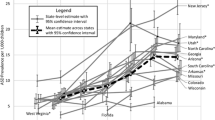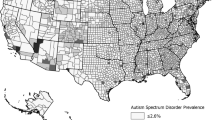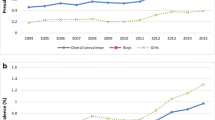Abstract
U.S. national and state population-based estimates of adults living with autism spectrum disorder (ASD) are nonexistent due to the lack of existing surveillance systems funded to address this need. Therefore, we estimated national and state prevalence of adults 18–84 years living with ASD using simulation in conjunction with Bayesian hierarchal models. In 2017, we estimated that approximately 2.21% (95% simulation interval (SI) 1.95%, 2.45%) or 5,437,988 U.S. adults aged 18 and older have ASD, with state prevalence ranging from 1.97% (95% SI 1.55%, 2.45%) in Louisiana to 2.42% (95% SI 1.93%, 2.99%) in Massachusetts. Prevalence and case estimates of adults living with ASD (diagnosed and undiagnosed) can help states estimate the need for diagnosing and providing services to those unidentified.


Similar content being viewed by others
References
American Psychiatric Association. (2013). Diagnostic and statistical manual of mental disorders (5th ed.). Washington, D.C: American Psychiatric Association.
Baio, J., Wiggins, L., Christensen, D., et al. (2018). Prevalence of autism spectrum disorder among children aged 8 years - autism and developmental disabilities monitoring network, 11 sites, United States, 2014. MMWR Surveillance Summaries, 67(6), 1–23.
Brugha, T. S., McManus, S., Bankart, J., et al. (2011). Epidemiology of autism spectrum disorders in adults in the community in England. Archives of General Psychiatry, 68(5), 459–465.
Croen, L. A., Zerbo, O., Qian, Y., et al. (2015). The health status of adults on the autism spectrum. Autism, 19(7), 814–823.
Gelman, A., Carlin, J. B., Stern, H. S., & Rubin, D. B. (2013). Bayesian Data Analysis. New York: CRC Press.
Gilboa, S. M., Devine, O. J., Oster, M. E., et al. (2016). Congenital health defects in the United States. Estimating the magnitude of the affected population in 2010. Circulation, 134, 101–109. https://doi.org/10.1161/circulationaha.115.019307.
Gillberg, C., Billstedt, E., Sundh, V., & Gillberg, I. C. (2010). Mortality in autism: A prospective longitudinal community-based study. Journal of Autism and Developmental Disorders, 40(3), 352–357. https://doi.org/10.1007/s10803-009-0883-4.
Hirvikoski, T., Mittendorfer-Rutz, E., Boman, M., et al. (2016). Premature mortality in autism spectrum disorder. British Journal of Psychiatry, 208(3), 232–238.
Janvier, Y. M., Harris, J. F., Coffield, C. N., et al. (2016). Screening for autism spectrum disorder in underserved communities: Early childcare providers as reporters. Autism, 20(3), 364–373. https://doi.org/10.1177/1362361315585055.
Kogan, M. D., Vladutiu, C. J., Schieve, L. A., et al. (2018). The prevalence of parent-reported autism spectrum disorder among US children. Pediatrics, 142(6), 1–11.
Mouridsen, S. E., Bronnum-Hansen, H., Rich, B., & Isager, T. (2008). Mortality and causes of death in autism spectrum disorders. Autism, 12(4), 403–414.
Murphy, C. M., Wilson, C. E., Roberston, D. M., et al. (2016). Autism spectrum disorder in adults: diagnosis, management, and health services development. Neuropsychiatr Dis Treat, 2016(12), 1669–1686.
Nicolaidis, C., Kripke, C. C., & Raymaker, D. (2014). Primary care for adults on the autism spectrum. Medical Clinics of North America, 98(5), 1169–1191.
Pickett, J. A., Paculdo, D. R., Shavelle, R. M., et al. (2006). 1998–2002 Update on "Causes of death in autism". Journal of Autism and Developmental Disorders, 36(2), 287–288.
Quinlan, C. A., McVeigh, K. H., Driver, C. R., et al. (2015). Prental Age and autism spectrum disorders among New York City children 0–36 months of age. MCHJ, 19, 1783–1790.
Rosenberg, E. S., Rosenthal, E. M., Hall, E. W., et al. (2018). Prevalence of hepatitis C virus infection in US states and the District of Columbia, 2013 to 2016. JAMA Netw Open, 1(8), e186371.
Rotholz, D. A., Kinsman, A. M., Lacy, K. K., et al. (2017). Improving early identification and intervention for children at risk for autism spectrum disorder. Pediatrics. https://doi.org/10.1542/peds.2016-1061.
Roux, A. M., Shattuck, P. T., Rast, J. E., Rava, et al. (2015). National autism indicators report: Transition into Young Adulthood. Life course Outcomes Research Program. Philadelphia, PA: A.J. Drexel Autism Institute Drexel University.
Schieve, L. A., Rice, C., Devine, O., et al. (2011). Have secular changes in perinatal risk factors contributed to the recent autism prevalence increase? Development and application of a mathematical assessment model. Annals of Epidemiology, 21(12), 930–945.
United States Department of Health and Human Services (US DHHS), Centers for Disease Control and Prevention (CDC), National Center for Health Statistics (NCHS). (2018a). Bridged-Race Population Estimates, United States July 1st resident population by state, county, age, sex, bridged-race, and Hispanic origin. Postcensal population estimates. Retrieved July 29, 2019, from https://wonder.cdc.gov/bridged-race-v2017.html.
United States Department of Health and Human Services (US DHHS) Centers for Disease Control and Prevention, National Center for Health Statistics. (2018b). Underlying Cause of Death 1999–2017. Retrieved July 29, 2019, from https://wonder.cdc.gov/bridged-race-v2017.html.
Disclosure
The findings and conclusions in this paper are those of the authors and do not represent the official position of the Centers of Disease Control and Prevention.
Author information
Authors and Affiliations
Contributions
PMD conceived of the study, wrote the manuscript except for the methods; CER provided statistical expertise and conducted the analysis, wrote the methods section of the manuscript; DM conducted an independent analysis for quality control, downloaded and prepared data for analysis, and created Figures 1 and 2; MM provided statistical and data expertise. All authors reviewed and approved the final manuscript as submitted and agreed to be accountable for all aspects of the work.
Corresponding author
Additional information
Publisher's Note
Springer Nature remains neutral with regard to jurisdictional claims in published maps and institutional affiliations.
Electronic supplementary material
Below is the link to the electronic supplementary material.
Rights and permissions
About this article
Cite this article
Dietz, P.M., Rose, C.E., McArthur, D. et al. National and State Estimates of Adults with Autism Spectrum Disorder. J Autism Dev Disord 50, 4258–4266 (2020). https://doi.org/10.1007/s10803-020-04494-4
Published:
Issue Date:
DOI: https://doi.org/10.1007/s10803-020-04494-4




